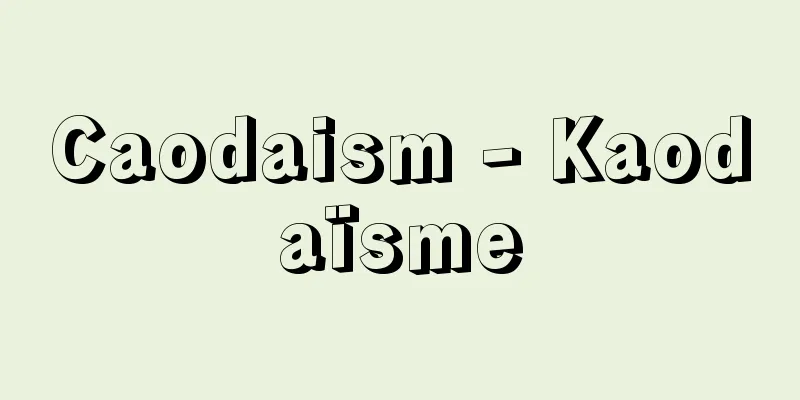Caodaism - Kaodaïsme

|
A Vietnamese religion that arose in 1926 in Tay Ninh Province, northwest of Saigon (now Ho Chi Minh City). At one time, the number of believers reached 400,000 (officially 2 million). Cao Dai (the high ground) is the name of the temple of the Supreme Being, the Supreme God of the Universe, but it is also the name of the God himself. A huge eye called the "Eye of Heaven" built in this temple is the symbol of this God. The founder of the religion, Le Ben Trung (黎文常) is said to have founded this religion after receiving a revelation from the Supreme Being, "Da Dao Tam Ki Huo Do." He claims that the Supreme Being, the Supreme Being, sent a Messiah to this world three times to save mankind, the first being Moses in the West, the second being Shaka in the East, the second being Jesus and Laozi, and the third and final time being himself. The characteristics of Cao Daiism include (1) the "Unification Principle"-like idea of integrating the three indigenous religions of Confucianism, Buddhism, and Taoism with imported Christianity, as mentioned above, (2) the messianic idea that the founder was a savior sent by God, (3) many of the founders and other important people had shamanic qualities, (4) the concept of an ideal society (utopia) based on the "Daido" idea found in the Confucian scripture "Book of Rites," and (5) the borrowing of rites and official systems from Roman Catholicism. Some of these characteristics are common to several religions that have arisen in modern East Asia, such as the Taiping Heavenly Kingdom (1851-64) at the end of the Qing Dynasty in China and the Unification Church (Principle Movement) that arose in Korea after World War II. During World War II, the Cao Dai sect was oppressed by the colonial authorities for its anti-French stance (1942), and after the war, it fought armed conflict with the Saigon regime in South Vietnam and was oppressed (1957), and also participated in the National Liberation Front and sent representatives to the National Assembly in North Vietnam along with other religions, drawing attention for its political connections. After the fall of Saigon (1975) and the unification of North and South Vietnam (1976), it is said that the Cao Dai sect as a whole was oppressed because some of its members led anti-government movements. [Mitsuo Tomikura] Source: Shogakukan Encyclopedia Nipponica About Encyclopedia Nipponica Information | Legend |
|
1926年にサイゴン(現在のホー・チ・ミン市)北西のタイニン省を中心におこったベトナムの宗教。信徒数が40万(公称200万)に達したこともある。カオダイ(高台)とは宇宙の至上神である天帝の神殿の名称だが、その神の名でもある。この神殿につくられてある「天眼」とよばれる巨大な目がこの神の象徴。教祖レ・ベン・チュン(黎文忠(れいぶんちゅう))は天帝から「大道三期普度(ダイダオタムキフオド)」という啓示を受けてこの宗教を創始したという。至上の神なる天帝は人類救済のため三度にわたってこの世に救世主(メシア)を遣わしたといい、最初は西欧ではモーセ、東洋では釈迦(しゃか)、二度目はイエスと老子、そして最後の三度目に遣わされたのが自分であると主張する。 カオダイ教の特徴として、(1)前述の主張にみるように、在来の儒仏道三教などと外来のキリスト教を統合しようとする「統一原理」的な発想、(2)教祖を神が派遣した何回目かの救世主とするメシア思想、(3)教祖ほか重要な役割を果たす人物にシャーマン的資質の持ち主が多いこと、(4)儒教経典『礼記(らいき)』にみられる「大同(だいどう)思想」に基づく理想社会(ユートピア)の構想、(5)ローマ・カトリック教からの儀礼や職制などの借用、などを指摘できる。それら特徴のいくつかは、中国清(しん)末の太平天国(1851~64)や第二次世界大戦後の韓国におこった基督(キリスト)教統一教会(原理運動)など近代以降の東アジアにおこった宗教のいくつかに共通するものである。 カオダイ教は、第二次大戦中、反フランス的立場をとったため植民地当局の弾圧を受けたり(1942)、戦後は、南ベトナムではサイゴン政権と武力抗争をして弾圧されたり(1957)、あるいは解放民族戦線に参加したり、北ベトナムでは他の諸宗教とともに国民議会に代表を送るなど、政治との関係でも注目された。サイゴン陥落(1975)、南北ベトナムの統一(1976)以後は、その一部が反政府運動を指導したため、全体として弾圧されたといわれる。 [冨倉光雄] 出典 小学館 日本大百科全書(ニッポニカ)日本大百科全書(ニッポニカ)について 情報 | 凡例 |
<<: Face showing - face showing
>>: Chaos - Kaos (English spelling)
Recommend
Ryugasaki [city] - Ryugasaki
A city in the southern part of Ibaraki Prefecture....
Crocodile River
…Its total length is 1,770 km (7th largest in Afr...
Portamento (English spelling) portamento Italian
A technique in Western music. It is a technique f...
Ahmet Nedim
A court poet of the Ottoman Empire. Born in Istan...
al-Zamakhsharī, Abū al-Qāsim Maḥmūd
[Born] March 8, 1075. Khwarizm [Died] June 14, 114...
Terracotta - Terracotta (English spelling) Italian
The original meaning is baked earth, red clay, or...
European Parliament
…the collective name for the three supranational ...
Phonemics
The branch of phonology that analyzes sounds or p...
Household Agency - Ieukekaisho
…A characteristic of these urban residents is tha...
Albert Memorial Chapel
…St. George's Chapel was built for the Knight...
T-square - T-square
A T-shaped drafting ruler. The T-shaped part is fi...
Rājshāhi (English spelling)
A city in western Bangladesh. It is the capital of...
Ishikushiro
It means a stone bracelet. However, the term ishi...
khsier
...One of the devices for smoking tobacco. The cu...
Hamada Yahyoe
Years of birth and death unknown. Captain of a re...









